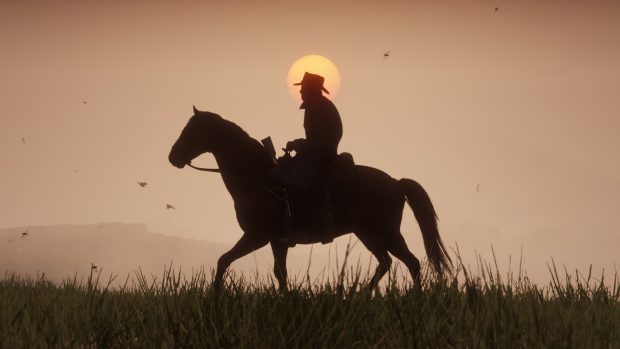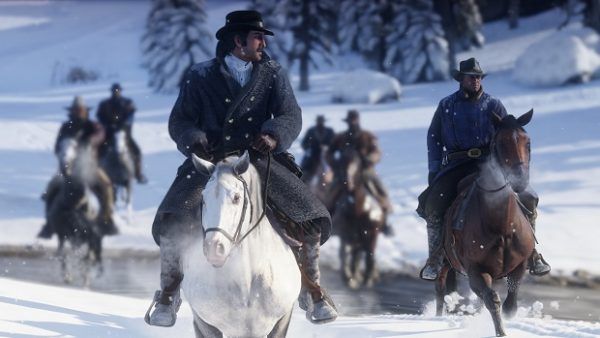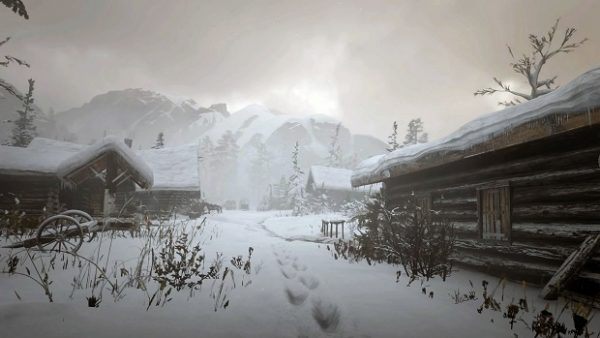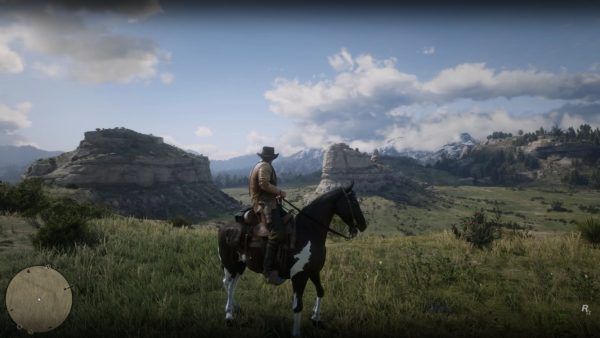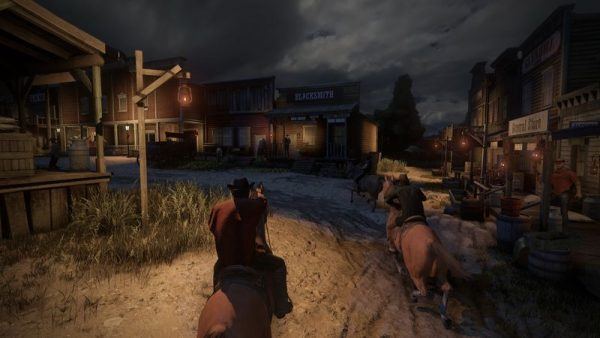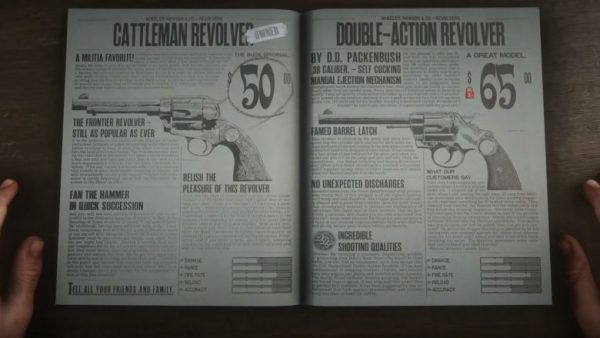Be it the pastoral plains of the southeast or the enfeebling snow-covered mountains of the northwest, Red Dead Redemption 2 captivates the mind with a world inundated by colorful personalities, random encounters with the wild, and a deluge of activities to lose yourself in.
Few games can capture the true zeitgeist of their respective eras the way Red Dead Redemption 2 does. Set back 12 years prior to the start of its predecessor (confusingly making it a prequel with the name of a sequel), this Wild West tale of criminal outlaws and pariahs in a world that scowls at them is a throwback to the times America was changing. A year before the start of the 19th century and the mythos of the American Frontier is beginning to fade. Outlaws are more fringed than ever, hunted with fervor by the newly forming lawful USA. Progressive movements have swooped across the country, taking it by storm and flushing out those lost in their archaic ways.
Caught amidst this cross-country paradigm shift is Dutch Van der Linde’s gang – a collection of castaways and social rejects that have taken the reprehensible route of robbing, heisting, and stealing to make ends meet. Without a place to call home, they seek to escape the tightening shackles of this New America by hopping from one camp setup to another, hoping one will finally stick.
This nomadic lifestyle is credited to a failed robbery of a boat that raised the bounty on this already-notorious gang after it had ridden its uncontrolled infamy for years in Blackwater. The premise of the game is set behind screen, with the failed heist carried in the absence of our protagonist and Dutch’s right-hand man, Arthur Morgan. Thrown into this precarious situation, Arthur is forced to move away from the place he once called home – leaving all worldly materials behind, hoping against hope they’re never found by the bloodthirsty lawmen of the new century and the avaricious bounty hunters that assist them.
You’re introduced to the many members of the gang as they traverse the treacherous mountains in an unforgiving blizzard. It’s the only place where the law wouldn’t find them, Dutch reckons, and despite the death of a wounded ally early on, the camp’s fortitude is unhindered under Van der Linde’s portentous leadership. It’s a grounded introduction that sets the tone for the rest of the 60+ hours of storytelling, reminiscent of the premise of Quentin Tarantino’s The Hateful Eight. Red Dead Redemption 2 is a character study, and it acknowledges it from the first minute till the last.
The first few hours are a series of linear introductory missions that play the role of tutorials. You’re seamlessly integrated into the world with no introduction to the many gang members that will accompany you for the rest of the game. Riding on missions with your brethren gradually unveils each’s unique personality and foibles, but it’s a process the game takes its time with, carrying it beyond the first chapter and deep into the second.
There’s not much to take away from the frostbitten landscape of the prologue. Missions here serve to introduce game mechanics and underscore the delicate situation the gang finds itself in, as well as presenting snippets of Arthur Morgan’s personality and his rank among his peers. It’s a slow burn that may not engage the most casual gamer, but like any Wild West character study, this is a marathon, not a sprint. It’s a game that presents every moment with much deliberation and care, and the tone and pace are set from the get-go – no one is fooled into mistaking it as your contemporary open-world action title. If you’ve played Assassin’s Creed: Odyssey prior to this, the difference in presentation can be staggering, despite both claiming to belong to the same genre.
The map opens from Chapter 2 onward as the gang moves east. Snowy hills are replaced by vast, lustrous plains and grassy knolls. The desolate winter theme is left behind for a lively country engorged by average men and women. Believable NPCs ride their mount and wagons as you traverse this landscape; people cultivate their farms, bicker and brawl, and pass by without ever paying you a moment’s notice. You’re not the center of the world here; you’re merely a passerby with a negligible footprint in the most accurate representation of the wild west in any videogame.
Stunning visuals and animations are ubiquitous. Rockstar wasn’t known for visually stunning games, but Red Dead Redemption 2 is right up there with the best looking console games ever made. The signature western dulled grass carpets the vast plains, peppered with rugs of green on steep hills. Pools of lakes are sprinkled sporadically across the map for a calm sail on a boat you’ll “borrow” from the shore, and rivers slither across the borders of each state – some gently, others at a frantic pace. The immaculate attention to detail breathes life into a world that is as full of character as the protagonist himself.
It’s not the picturesque scenery that takes the limelight though. The animations are centerstage here and some of the finest in videogaming history. From the lifelike motion of the horses to Arthur’s walking gait, Red Dead Redemption 2’s animations are almost unparalleled. Foliage is the most accurate in any game in representation and physical behavior, weaving and bending as characters work their way through dense forests and around isolated plants. Horse manure and mud wash off your clothes after a mishap when you take a swim in a river or a stroll in the rain. This is one of the finest displays of human observation and its translation into a virtual world you will find in videogaming.
In Chapter 2, the richness of the world comes like a thundering strike as the game withdraws its initial constraints. You’re free to roam in the and carry out the story missions at your own pace, taking in the grand design of this busy world. Exploration is encouraged, as there is no immediately noticeable fast travel system to teleport you from your camp to your favorite saloon for a round of drinks or a game of Five Fingers. Your horse quickly becomes your greatest companion in the lengthy journeys from one corner of the visible map to another.
Yet the world itself is hardly overbearing. Red Dead Redemption 2 doesn’t try to bloat itself with unnecessary filler content. Each side-quest, each activity, each story mission is unique and played out with fine detail. The world isn’t in a rush to move you forward, and Arthur Morgan isn’t in a rush to leave his mark on it. Rockstar wants you to savor every moment, and it’s indicated by how much foot they’ve taken off the gas with this title.
You can’t run while at your own camp, for example. You’re encouraged to bond with your horse, feed it to maintain its health and stamina, and avoid overstressing it with prolonged top-speed sprints. Your clothes need to be changed regularly, and sleep is as important as food to ensure your health replenishes at a reasonable rate. Every enemy you gun down needs to be searched individually for loot, every carbine shot you take needs to be followed by a cock of the lever to cycle a new round, and weapons need to be oiled after prolonged use to maintain their performance. Even your hat has to be picked upon losing it during a rough brawl. It’s a game that revels in its own pace by sprinkling semi-realism in all its mechanics.
Eventually, these tasks after the umpteenth hour start feeling like chores. Speeding through the quests no longer becomes an option as Arthur takes his merry time carefully opening every cabinet drawer, laboriously looting every corpse, and brushing away the dust from every horse he ever owned. All the eating, cooking, drinking, and horse-tending animations are deliberately drawn out, as if partly to show off the punctilious care in which they were replicated from life-like examples. Yet holistically these are the elements that make Red Dead Redemption 2 unique. Rather than a handful of memorable missions, it’s the immersion in this unhurried world and the experiences you extract out of it that sets this game apart.
Each mission is carried out at the request of and/or alongside a gang member, of which some you get along more with than others. The varying personalities and traits of each character give a different flavor to every quest you partake in. Micah’s unpredictability and caustic nature ends seemingly simple jobs in chaos. Hosea’s experience in artifice and spiel with the common-folk gets you serving drinks to a full-house saloon. Uncle’s indolence often results in unnecessary complications that have you headbutting with the wrong foes for a mere pittance. Every character brings a different facet to the game’s vast world and the tasks that lay in it for you to complete.
Every set-piece and/or mission is assisted with relevant music. The score accentuates every memorable cutscene and instance in the game, be it a frivolous drunken party or a poignant interaction with your previous love. Rockstar nailed the thematic aspects of the game, and the music is just another incredible part of it. Combat music invigorates the individual, feeling like a true gunslinger in the midst of a heist gone wrong or a violent shootout with a rival gang.
Gun battles aren’t a part of every main mission, which is a plus despite it being one of the game’s strongest points. The tried and tested third-person cover system returns, as does Dead Eye. Yet despite little innovation in the combat, each battle plays out with superb unpredictability. In the truest wild west fashion, combat is drawn out by use of era-appropriate weapons. “Repeater” carbines are your fastest class of weapons, and they require a manual pull of the lever (with the tap of the fire button) after every shot. Dead Eye is invaluable in landing headshot after headshot – often requirements to earn gold medals for most missions. The exchange of lead between you and your foes with these slow weapons gives the game a great sense of American Frontier authenticity. And while the weapon arsenal is limited, it never feels like an inferior gun is stumping your progress so long as you maintain it.
Weapons are found across the expansive world, looted form corpses of your dead, stolen from stagecoaches, rewarded as part of story missions, or bought from the Gun Smith. The Gun Smith gives a reliable set of weapons for each category, along with ammunition and gun customization, but you’ll have to explore the world to get your hands on the best the Wild West has to offer.
Unfortunately, a journey from one part of the map to the other isn’t as easy. There’s no obvious fast travel system in Red Dead Redemption 2 – at least not initially. There are a few ways to get about quicker than a horse ride – such as purchasing a one-time ticket for the train or a stagecoach – but the stops are far and few, only connecting major towns, with longer-than-required cut-scenes about absolutely nothing. A more familiar fast-travel systm can be unlocked, but it requires hunting for various items and spending over $500; even then, this fast-travel is only accessible from your camp, and it doesn’t let you travel back to the camp from any other location. You’re forced into the grueling task of traversing the uneven terrain of the world every time you set out for a purpose. It’s gorgeous every time, but it artificially lengthens the campaign.
The game often felt like a horse simulator to me – where I had to stop to feed my debilitated horse, then proceed to ride on it while carefully monitoring its stamina and health. A trip into a puddle of mud while trying to hop over a fence meant the horse, now dirty, would replenish stamina and health slower, forcing me to brush it clean or run it through a deepish river.
This egregious nature of travel is underscored further when riding with NPC companions during a story mission. Banter ensues, forcing Arthur and the companions to travel at a restrictive pace. The game ignores your frantic mashing of the sprint button during such sequences, constraining you to a predetermined speed. You’re forced to stop at instances you don’t wish to, while simultaneously expected to adhere to the game’s attempt at hyper-realism. This juxtaposition of inhibiting semi-realism and restrictive scripted scenarios often puts the user experience in an awkward spot. It belies the game’s wish to remain a videogame, but also belies its attempt to engross the player.
Red Dead Redemption 2 also eschews itself from the responsive control scheme most gamers are accustomed to. Relying on numbers and important gameplay information is discouraged. Hints and tips are relegated to the top-left corner of the screen, only appearing for a few seconds. Ammo count is pasted at the top left in a light gray collect scheme whenever you draw your weapon. A press of a button or the tilt of your analog stick doesn’t follow with snappy and swift movement from Arthur or your horse like you’d expect. An intrinsic inertia is involved in every motion that follows an input from the player, as if you’re merely an instructor to the protagonist instead of the individual in possession of them.
This subtle disconnect is more noticeable when riding your horse. Coaxing your horse (or rather Arthur’s horse) forward at its fastest speed requires rhythmic pressing of the sprint button in harmony with the horse’s hoofbeats. Every tug has a few milliseconds of parlous delay, resulting in infrequent collisions with passing civilians and carriages to instigate unnecessary conflicts.
I once accidentally bumped into a lawman in the gentlest way with my horse during my visit to Valentine, the first town in the game. The resulting chaos was a messy gunfight that raised the bounty on my head twofold – a completely inadvertent butterfly effect that was a product of the game’s unforgiving fidelity (or the lack of).
These clunky, arduous controls are broad-stroked across the entire interface. Switching weapons or selecting items from the wheel is a messy amalgam of holding/releasing buttons and toying with the right analog stick. Basic interactions like changing your clothes or sleeping require a prolonged press and hold of a button. Picking an object off the floor or hitching your horse requires careful repositioning for the prompt to appear. I usually adjust to even the more counterintuitive controls in a videogame, but Red Dead Redemption 2 had me feeling uncomfortable till the fourth chapter with its preternatural interface.
The writing and dialogue of Red Dead Redemption 2 is its highlight and what keeps the user glued to the screen and controller despite its inelegant control scheme. Witty lines combine incredibly well with fantastic voice acting to keep the seemingly dullest moments zesty and fresh. Every character is uniquely voice acted – whether it’s a gang member or some average lowlife you come across at a barn, you’ll treat them as a unique individual solely based on how and what they say.
The loquacious Sean, the excessively formal Trelawny, the taciturn Charles, or the arrogant false prophet Dutch – every character is distinguished more by their voice acting and dialogue than their looks. The enunciation of the deeply-embedded southern accents is on point for every individual that inhabits the world, never seeming artificial or forced – each character’s conversational demeanor pays homage to their behavior and personality.
The key inhabitants of this vast open world drive the story of Red Dead Redemption 2 forward. The comeuppance that arrives for Dutch and his gang is already known from the 2010 predecessor, so Red Dead 2 instead focuses on the tale of this group at the height of its notoriety. Unyielding loyalty to a grandiloquent and self-deluded man such as Dutch brings chaos and bedlam to every town they touch.
Dutch’s futile promises of a grander tomorrow indoctrinates the group to carry out heinous crimes. Just a little more money to reach our final destination, he says. Just one more town to con and upheaval before we’re untouchable, he reckons. It’s a story of a band of brothers attaching meaning to their leader’s hollow previsions of grandeur and peace even when they bring death and destruction to everything they touch.
The story moves at a steady pace, a gestalt of the deliberate fractal mechanics that form the experience. You’ll often do several main missions in sequence without the sensation of real narrative progress. Banter and confabulations among the characters during your many journeys grant valuable insight into each’s idiosyncrasies and past life, but it often feels like Red Dead Redemption 2 comes to a complete narrative halt for several quests, then suddenly moves forward at a rapid pace within the span of a single mission.
Yet peppered within this tortuous method of story-telling are unforgettable moments that, by the end of its two brilliant epilogues, make the grueling struggle with the game’s interface and pacing issues a worthwhile experience. It’s not a videogame littered with adrenaline pumping action and sheer joy. It frustrates the user only to placate them with some wonderful moments. It battles against what you know about videogaming to deliver an enriched world like no other, rife with detail to a fault.
Red Dead Redemption 2 isn’t a flawless game, but it’s a pastiche of the wild west that few movies, TV shows, or videogames could compete with. It’s an experience every serious gamer needs to experience, even if it means motoring through its flagrant game-play mechanics and odd pacing.
